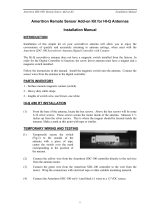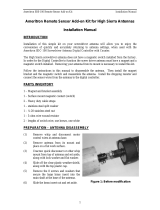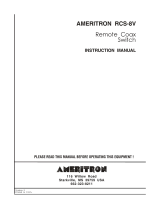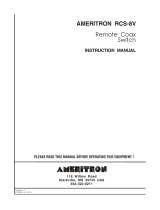Page is loading ...

1
AMERITRON ARF-500K
REMOTE FILTER PC BOARD
INSTALLATION MANUAL
WARNING: Ameritron strongly recommends you NOT attempt this modification if you are not familiar
with proper construction techniques, or you do not have proper electronics tools.
Improper Installation of the ARF-500K will void the warranty of the ARF-500K and/or the
amplifier. SAFETY GLASSES ARE REQUIRED!
INTRODUCTION
The Ameritron ARF-500K is a filtering circuit that allows the ALS-500M to be used with the ALS-500RC
(remote head). The ARF-500K is design to be used with Ameritron ALS-500M with serial number 13049 or less.
Current production model with serial number ending with an “R” is already compatible for the ALS-500 Remote
Head.
The ALS-500 Remote Head allows the amplifier to be placed away from the operating station and still have
access of the front panel controls. The Remote Head has a Frequency Select Switch, ON/OFF Switch, Relay
control jack, Current Meter, and three LEDs for TX, O/L and Power.
The ALS-500M will still have front panel controls (ON/OFF, Frequency Select, and Thermal overload, Load fault
indicators), along with remote capability after the new filter circuit is installed.
INSTALLATION
The following Items are supplied: (1) Ameritron Remote Head
(1) Face Plate
(1) Remote Filter PCB with rotary Switch attached
(2) Modular Patch cable (RJ-45) 25’
(1) Knob
(4) 4-40 X 25” Screw
(4) #4 INT Lock Washer
Tools Required: Safety Goggles
#1 Flat Screw Driver
#1 & #2 Phillip Screwdriver
½” Nut Driver
5/64” Allen Driver
42 Watt Soldering Iron
60/40 solder
Wire Strippers
Ohm Meter
CAUTION
: Always disconnect the power mains before removing the cover of the amplifier.
ALWAYS WEAR EYE PROTECTION DURING INSTALLATION
1. Remove power connection and other cables from the amplifier. Place the amplifier in a well-lit area with
adequate workspace.

2
2. Remove the cover of the amplifier and place out of the way.
3. Notice the two high current red wires that are routed from pin 3 and 4 of the power jack through the meter and
connect to the PA PCB. Remove the wire ties that hold these wires together. Un-solder the wires from one
end and remove from the meter coupler and re-solder to the same location.
Note: Do not shorten the lengths of these wires!
4. Located the filter PCB. This board has the rotary switch and T/R relay soldered on it.. Remove the gray,
brown and paired red wires from the filter board -- located just behind the T/R Relay. Leave the other end of
the wires connected.
5. Remove the two small coax from the filter board. Be careful not to break the shield of the coax when un-
soldering.
6. Remove the black wire from the filter board located behind the meter.
7. Remove the knob and nut from the frequency select switch on the front panel.
8. The Thermal and Load Fault indicators snap into place from the inside of the front panel. By applying very
little pressure to the LED while spreading the clips apart will allow the LED to be removed from it’s socket.
Note
: Early production models may have a two-piece socket. The inside ring will have to be snap off
before the LED will come out of the socket. Remove the Thermal and Over Load LED from their
sockets.
9. Remove the four screws from the face plate and fold down to expose the On/Off Switch wiring connections.
10. The ON/OFF switch is easily damaged to heat. When un-soldering apply just enough heat to melt the solder
then quickly remove the wire. Remove the orange and paired red wires from the switch. Leave the black
wire connected to the switch.
11. Squeezing and pressing down the snaps against the switch with a flat blade screwdriver will allow the switch
to be removed from the faceplate. Remove the switch from the faceplate.
12. Place the amplifier on its side and remove the four screws that hold the Filter Board to the chassis. Then
place the amplifier back to its operating position.
13. Slide the filter board back and lift up. Un-solder the two coax from the bottom of the filter board. Remove
the filter board and place out of the way.
Note
: When soldering to the new filter board make sure the iron does not come in contact with the sealed relays.
A melted spot to the housing of the relay can cause the relay not to work.
14. On bottom of the new filter board there is a yellow dot. This is where the small brown coax, that comes from
the heat-sink (PA) board will solder to. This same point is label R01 on the top side of the board. Remove
the yellow dot and place the center conductor of the coax in the hole from the bottom side of the board and
solder. Solder the shield of the coax to the silver pad next to the hole. Make sure the non-insulated part of the
shield does not touch any other connection around it. See Figure 1
15. On bottom of the new filter board there is a blue dot. This is where the larger coax that comes from the RF
Output connector will connect. This is the same coax that was remove from the rear of the old filter board.
This location is label R02 on the top side of the board. Remove the blue dot and place the center conductor in
the hole from bottom side of the board and solder. Solder the shield to the silver pad next to the hole. See
Figure 1.

3
STEP 15 (BLUE DOT)
STEP 14 (YELLOW DOT)
16. Place the filter board into the amplifier with the modular jack towards the front of the amplifier and fold the
rotary switch back out of the way. Do not secure the board to the chassis at this time.
17. Solder the gray wire that was removed in step 4 to W307. See Figure 3.
18. Solder the brown wire that was removed in step 4 to the empty hole between C321 and C324. See Figure 3.
19. Solder the pair of red wires that was removed in step 4 to W309. See Figure 3.
Fi
g
ure 1

4
20. Locate the small coax coming from the RF IN Connector on back of the amplifier. Place the center conductor
of the small coax into RI1 hole and solder. Solder the shield to the silver pad with a hole, next to RI1. See
Figure 3. Caution: Do not touch relay with soldering Iron.
21. Locate the larger coax that comes from the combiner board. Cut the coax for the center conductor to fit into
the hole label RI2 and solder. Solder the shield to the silver pad next to RI2. See Figure 3. Caution: Do not
touch relay with soldering Iron
22. Locate bias board 862-0500-4. On the bias board there is a silver jumper near R404 and C401. Solder the
green wire from the new Filter Board to the silver jumper wire by apply a blob of solder on the end of the
wire. Lay the wire onto the silver jumper and solder. Hold the wire in place until cool, so the jumper will not
come out of the hole. See Figure 2.
23. Locate FB401 on the Bias Board (front right corner). Strip some of the insulation off the wire that goes
through the bead and solder the blue wire from the new Filter Board to it. See Figure 2.
STEP 22
STEP 23
Figure 2

5
24. Locate the Power Jack at the inside back of the amplifier. This is the jack where the main power plug
connects. Pins 3 and 4 have big red wires connected to them and run to the PA Board with the heat sink.
Notice on the PA board one wire is closer to the back than the other.
If there is a jumper connected between pins 3 and 4. Connect the red wire with the white stripe coming from
the new filter board to the jumper that connects pins 3 and 4 together.
25. Connect the red wire with black stripe coming from the new filter board to one of the big red wire located on
the PA board with the heat sink. Since there is a jumper between pins 3 and 4 it will not matter which wire
the red wire with black stripe is connected to.
Skip Steps 26 and 27.
If there is no jumper between pins 3 and 4. This jumper is removed when using two power supplies in parallel.
If using two power supplies in parallel do not connect a jumper. Continual with steps 26 and 27. If using one
power source add a jumper from pin 3 to 4 and follow the previous two steps.
26. This step is for an amplifier that has no jumper between pins 3 and 4. Connect the red wire with white stripe
coming from the new filter board to pin 4 with the big red wire.
27. The red wire with black stripe coming from the new filter board must connect to the other end of the same big
red wire. Determine which wire is which by un-twisting the red wires or use an ohmmeter. To check with an
ohmmeter, place one lead of the ohmmeter to pin 4. Next, touch the other lead of the ohmmeter to one of the
red wires at the PA board. If the ohmmeter reads zero ohms (shorted), then connect the red wire with black
stripe to this wire. If the ohmmeter read high resistance then move the lead to the other wire on the PA board.
This wire should read zero ohms. Connect the red wire with black stripe to this wire.
28. The ON/OFF switch has three terminals. One of the terminals with the black wire is a different color than the
other two. Position the terminal with the black wire to the top and snap the ON/OFF switch into the front of
the new Face Plate.
29. Route the red LED through the front bottom left hole of the chassis and snap into the Load Fault socket of the
faceplate.
30. Route the yellow LED through the front top left hole and snap into the Thermal Overload socket.
31. Twist the orange wire from the new Filter Board with the orange wire that was removed from the Power
Switch. Route the wires through the power switch hole of the chassis. Solder to the center terminal of the
Power Switch by applying a blob of solder on the end of the wire. After applying the solder, lay the wire to
the terminal and apply just enough heat to flow the solder to the terminal.
32. Twist the red wire from the new filter switch board (board with the rotary switch) with the two red wires that
was removed from the Power Switch. Route the wires through the power switch hole of the chassis and
solder to the bottom terminal.
33. Secure the faceplate to the front of the amplifier with the four black screws and washers.
34. Solder the black wire from the power switch to the silver ground pad next to RI2. See Figure 3.

6
STEP 17
gray wire
STEP 1
8
brown wire
STEP 19
pair of red wires
STEP 21
large coax from
combiner PCB
STEP 34
black wire from
power switch
Figure 3
35. Secure the new Filter Board to the chassis with the supplied small silver screws.
36. Remove the nut from the rotary switch with out letting the silver stop washer fall off. If the washer falls off,
make sure the tap goes back into number 7 with the switch in the fully counter clockwise position.
37. Place the switch through the front panel with the wires routed toward the Power Switch. Place the nut back
onto the switch and tighten. Do not tighten more than 1/8 of a turn beyond hand tight.
38. With the rotary switch in the fully counter clockwise position, place the supplied one-inch skirt knob onto the
shaft and align to the remote position and tighten. Do not use the bar type knob that was remove form the old
filter board. The bar knob can cause too much torque to the switch.

7
Figure 4
39. If the 10 Meter Board was install on the old filter board, remove and install on new filter board.
40. Inspect all wire connections. Make sure wires are not routed against the fan, relay or any components that
carry RF.
41. Measure with an ohmmeter from the high current leads to ground. Should read greater than 100K ohms.
42. Remove any debris left in the amplifier
43. Secure cover back onto amplifier.
Refer to the Manuals for the Remote Head and Amplifier for operation.
TECHNICAL ASSISTANCE
Technical Assistance is available on weekdays between the hours of 8:00 AM to 4:30 PM Central Standard Time.
Ameritron
116 Willow Road
Starkville, MS 39759
Tel: (662) 323-8211
Fax: (662) 323-6551
email: ameritron@ameritron.com
/











